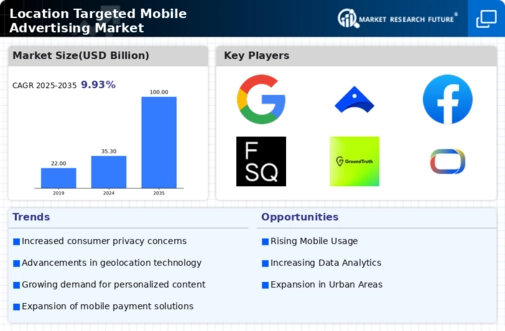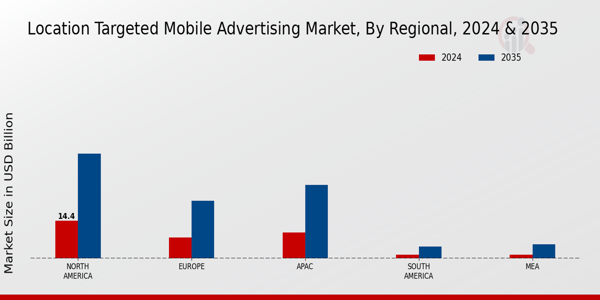Market Growth Projections
The Global Location Targeted Mobile Advertising Market Industry is poised for substantial growth, with projections indicating a market value of 35.3 USD Billion in 2024 and an anticipated increase to 100 USD Billion by 2035. This growth trajectory reflects the increasing adoption of mobile devices and advancements in advertising technologies. The compound annual growth rate of 9.92% from 2025 to 2035 suggests a robust expansion as businesses increasingly recognize the value of location-targeted strategies. This upward trend underscores the importance of adapting to changing consumer behaviors and leveraging location data effectively.
Increasing Smartphone Penetration
The proliferation of smartphones globally serves as a primary driver for the Global Location Targeted Mobile Advertising Market Industry. As of 2024, the number of smartphone users is projected to reach approximately 6.8 billion, facilitating a broader audience for advertisers. This widespread adoption enables brands to leverage location data effectively, targeting consumers based on their real-time geographical context. The ability to deliver personalized advertisements based on user location enhances engagement rates, potentially leading to higher conversion rates. Consequently, the market is expected to grow significantly, with projections indicating a value of 35.3 USD Billion in 2024.
Advancements in Geolocation Technology
Technological advancements in geolocation capabilities are reshaping the Global Location Targeted Mobile Advertising Market Industry. Innovations such as GPS, Wi-Fi triangulation, and Bluetooth beacons allow advertisers to pinpoint user locations with remarkable accuracy. This precision enables businesses to create hyper-targeted campaigns that resonate with consumers in specific locales. For instance, retailers can send promotional offers to users within a certain radius of their stores, enhancing foot traffic and sales. As these technologies continue to evolve, the market is likely to witness substantial growth, with a projected value of 100 USD Billion by 2035.
Rising Demand for Personalized Advertising
The growing consumer expectation for personalized experiences drives the Global Location Targeted Mobile Advertising Market Industry. Consumers increasingly prefer advertisements tailored to their preferences and locations, leading brands to adopt location-based strategies. This trend is evident in the rise of mobile applications that utilize location data to deliver relevant content. For example, restaurants may target users nearby with special offers, thereby increasing customer engagement. This shift towards personalization is anticipated to contribute to a compound annual growth rate of 9.92% from 2025 to 2035, indicating a robust future for the market.
Growing E-commerce and Mobile Shopping Trends
The expansion of e-commerce and mobile shopping significantly influences the Global Location Targeted Mobile Advertising Market Industry. As more consumers turn to mobile devices for shopping, businesses are compelled to adopt location-based advertising strategies to capture this audience. For instance, retailers can utilize geofencing to send notifications about sales or promotions to users who enter a designated area. This approach not only enhances customer engagement but also drives sales conversions. The increasing reliance on mobile shopping is expected to contribute to the market's growth, reinforcing the importance of location-targeted advertising in the digital landscape.
Integration of Location Data with Marketing Strategies
The integration of location data into broader marketing strategies is becoming essential for businesses within the Global Location Targeted Mobile Advertising Market Industry. Companies are increasingly recognizing the value of combining location insights with consumer behavior data to enhance campaign effectiveness. This integration allows for more informed decision-making, enabling brands to allocate resources efficiently and optimize advertising spend. As organizations leverage advanced analytics to interpret location data, they can create more impactful marketing strategies that resonate with their target audience. This trend is likely to propel the market forward, aligning with the projected growth trajectory.





















